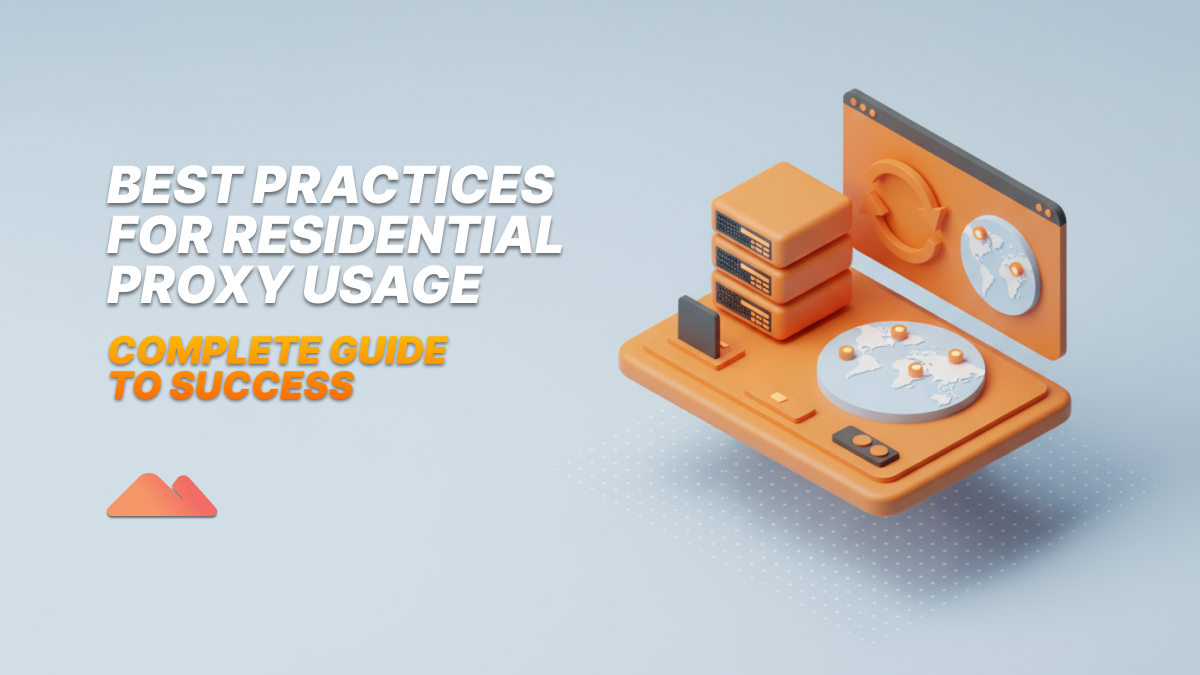TL;DR
Residential proxies offer unmatched anonymity and reliability for web scraping, market research, and data collection, but success depends on following best practices. Key strategies include rotating IP addresses regularly, respecting rate limits, choosing quality providers, implementing proper session management, and maintaining ethical usage standards.
When it comes to web scraping, market research, or any data collection activity that requires anonymity and reliability, residential proxies have become the gold standard. Unlike datacenter proxies, residential proxies use real IP addresses from actual internet service providers, making them virtually indistinguishable from regular user traffic.
However, simply having access to residential proxies isn't enough – how you use them determines your success. Whether you're a seasoned developer or just getting started with proxy technology, following established best practices can mean the difference between smooth, efficient operations and frustrating blocks and failures.
Understanding Residential Proxy Fundamentals
Before diving into best practices, it's crucial to understand what makes residential proxies unique. Understanding how residential proxies work shows that these proxies route your requests through real residential IP addresses, providing legitimate-looking traffic that's much harder for websites to detect and block.
The key advantage lies in their authenticity – websites see your requests as coming from real users in real locations, not from obvious proxy servers. This makes them invaluable for tasks like competitive intelligence, price monitoring, SEO research, and accessing geo-restricted content.

Essential Best Practices for Residential Proxy Usage
1. Implement Smart IP Rotation Strategies
One of the most critical aspects of residential proxy usage is proper IP rotation. Static IP addresses are easily detected and blocked, while smart rotation keeps your activities under the radar.
Rotation frequency considerations:
- For web scraping: Rotate every 5-15 requests, depending on the target site's sensitivity
- For social media monitoring: Use longer rotation intervals (50-100 requests)
- For e-commerce research: Rotate between different product pages or categories
The key is finding the balance – too frequent rotation can trigger security measures, while too infrequent rotation increases detection risk.
2. Respect Rate Limits and Request Patterns
Residential proxies don't give you a license to overwhelm target servers. Maintaining human-like browsing patterns is essential for long-term success.
Recommended practices:
- Implement delays between requests (2-5 seconds minimum)
- Vary your request timing to mimic natural user behavior
- Limit concurrent connections per IP address
- Use random delays rather than fixed intervals
Remember, even with the best residential proxies, aggressive scraping patterns will eventually trigger anti-bot measures.
3. Choose Your Proxy Pool Locations Wisely
Geographic targeting is one of the strongest advantages of residential proxies. Different locations can yield dramatically different results, especially for geo-sensitive content.
Location strategy tips:
- Match proxy locations to your target audience or market
- Test different geographic regions to identify optimal performance
- Consider time zone factors when scheduling automated tasks
- Use local proxies for region-specific compliance requirements
For businesses operating globally, analyzing residential proxy performance metrics provides valuable insights into performance variations across different regions.
4. Master Session Management
Proper session handling is crucial for maintaining consistency and avoiding detection. Each session should behave like a real user's browsing experience.
Session best practices:
- Maintain consistent user agents throughout a session
- Preserve cookies and session states appropriately
- Implement realistic session durations
- Handle session timeouts gracefully
- Use sticky sessions when needed for multi-step processes
5. Optimize Your User Agent Strategy
Your user agent string is often the first thing websites check when assessing request legitimacy. A poorly chosen or inconsistent user agent can immediately flag your traffic as suspicious.
User agent optimization:
- Use recent, popular browser user agents
- Match user agents to your proxy's geographic location
- Rotate user agents periodically but not too frequently
- Ensure user agent capabilities match your request headers
- Avoid outdated or uncommon user agent strings

Advanced Optimization Techniques
Error Handling and Retry Logic
Robust error handling separates professional implementations from amateur attempts. Residential proxies can occasionally fail due to network issues, IP blocks, or provider maintenance.
Effective error handling includes:
- Implementing exponential backoff for retries
- Distinguishing between temporary and permanent failures
- Maintaining fallback proxy options
- Logging errors for pattern analysis
- Setting reasonable timeout values
Performance Monitoring and Analytics
Continuous monitoring helps identify issues before they become problems and optimizes your proxy usage over time.
Key metrics to track:
- Success rates by proxy location
- Response times and latency patterns
- Block rates and failure reasons
- Bandwidth usage and cost efficiency
- Target website response patterns
Protocol and Security Considerations
When comparing SOCKS vs HTTP proxy protocols, residential proxies typically work with both protocols, but choosing the right one for your use case affects performance and compatibility.
Security best practices:
- Use HTTPS connections whenever possible
- Implement proper authentication methods
- Regularly audit your proxy configurations
- Monitor for unauthorized access attempts
- Keep proxy credentials secure and regularly updated
Common Pitfalls and How to Avoid Them
Over-Aggressive Scraping
The most common mistake is treating residential proxies as a license for unlimited requests. Even the best residential proxies can't protect against obviously non-human behavior patterns.
Warning signs of over-aggressive scraping:
- Consistently high request rates
- Immediate sequential page requests
- Ignoring robots.txt directives
- Not handling rate limiting responses
- Scraping during obvious off-hours
Ignoring Legal and Ethical Considerations
Residential proxy best practices aren't just about technical implementation – it's also about responsible usage that respects website terms of service and applicable laws.
Ethical usage guidelines:
- Review and respect robots.txt files
- Understand website terms of service
- Avoid scraping personal or sensitive information
- Implement reasonable rate limiting
- Consider the impact on target websites
Poor Provider Selection
Not all residential proxy providers offer the same quality or reliability. Choosing the right proxy providers for business requires careful evaluation of critical factors.
Red flags to avoid:
- Providers offering unrealistically low prices
- Lack of geographic diversity in proxy pools
- Poor customer support and documentation
- Unclear or suspicious proxy sources
- Inconsistent performance and reliability
Residential Proxy Management Tools and Techniques
Proxy Pool Management
Effective proxy pool management ensures optimal performance and longevity of your residential proxy operations.
Management strategies:
- Regularly test proxy health and performance
- Remove consistently failing proxies from rotation
- Balance load across your proxy pool
- Implement quality scoring for proxy selection
- Maintain backup proxy pools for critical operations
Integration Best Practices
Whether you're using residential proxies for enhanced online security, market research, or competitive intelligence, proper integration with your existing systems is crucial.
Integration considerations:
- Design for proxy failures and fallbacks
- Implement proper logging and monitoring
- Consider proxy costs in your scaling decisions
- Plan for proxy pool rotation and refresh
- Document your proxy usage patterns and policies

Industry-Specific Considerations
E-commerce and Price Monitoring
For e-commerce applications, residential proxies enable accurate price tracking and competitive analysis without detection.
E-commerce specific tips:
- Rotate between different product categories
- Mimic realistic shopping behavior patterns
- Handle dynamic pricing and session-based content
- Consider mobile vs. desktop user agents
- Respect shopping cart and checkout boundaries
SEO and Marketing Research
SEO professionals rely on residential proxies for accurate search engine result tracking and competitor analysis.
SEO optimization strategies:
- Use proxies matching your target market geography
- Implement realistic search behavior patterns
- Handle personalized search results appropriately
- Monitor for search engine algorithm changes
- Maintain consistent proxy locations for trending analysis
Social Media and Brand Monitoring
Social media monitoring requires careful handling to avoid triggering platform security measures while gathering comprehensive data.
Social media best practices:
- Respect platform rate limits strictly
- Use appropriate mobile or desktop user agents
- Implement realistic browsing patterns
- Handle authentication requirements properly
- Monitor for platform policy changes
Measuring Success and ROI
Key Performance Indicators
Tracking the right metrics helps optimize your residential proxy usage and demonstrate value to stakeholders.
Essential KPIs include:
- Data collection success rates
- Cost per successful request
- Time to data delivery
- Proxy uptime and reliability
- Compliance and risk metrics
Cost Optimization Strategies
Residential proxies represent a significant investment, making cost optimization crucial for sustainable operations.
Cost reduction techniques:
- Optimize request efficiency and reduce waste
- Choose appropriate bandwidth and concurrent connection limits
- Monitor usage patterns to identify optimization opportunities
- Negotiate volume discounts with providers
- Implement intelligent retry logic to reduce failed requests
Future-Proofing Your Residential Proxy Strategy
Staying Ahead of Detection Technologies
Website anti-bot technologies continue evolving, making it essential to stay current with best practices and emerging techniques.
Adaptive strategies:
- Monitor industry trends and detection methods
- Test new proxy technologies and approaches
- Maintain relationships with quality proxy providers
- Invest in continuous learning and skill development
- Plan for changing regulatory and compliance requirements
Scaling Considerations
As your data needs grow, your residential proxy strategy must scale efficiently while maintaining quality and compliance.
Scaling best practices:
- Design systems with horizontal scaling in mind
- Implement automated proxy management and rotation
- Plan for increased bandwidth and concurrent connection requirements
- Consider geographic expansion and multi-region deployments
- Develop robust monitoring and alerting systems

I am the co-founder & CEO of Massive. In addition to working on startups, I am a musician, athlete, mentor, event host, and volunteer.
Customer reviews
Frequently Asked Question
How many residential proxies do I need for my project?
+
The number depends on your request volume, target websites, and rotation strategy. Start with 10-20 proxies for small projects and scale based on performance. Generally, plan for 1 proxy per 100-500 requests per hour, depending on target site sensitivity.
Can I use the same residential proxy for multiple websites simultaneously?
+
While technically possible, it's not recommended. Using the same IP across multiple sites can create linkable patterns. It's better to dedicate specific proxies to specific targets or implement intelligent rotation across your proxy pool.
How long should I keep the same residential proxy IP before rotating?
+
Rotation frequency depends on your use case. For web scraping, rotate every 5-15 requests. For social media monitoring, every 50-100 requests may be sufficient. Monitor your success rates and adjust accordingly.
What's the difference between rotating and static residential proxies?
+
Rotating residential proxy services automatically change IP addresses at set intervals or per request, while static residential proxies maintain the same IP for extended periods. Rotating proxies offer better anonymity, while static proxies provide consistency for session-based activities.
How do I handle websites that require login or authentication with residential proxies?
+
Maintain session consistency by using sticky sessions, preserve cookies and authentication tokens, and avoid rotating proxies mid-session. Consider using dedicated proxies for authenticated sessions to maintain account security.
Are residential proxies legal to use?
+
Residential proxies themselves are legal, but usage must comply with website terms of service, applicable laws, and ethical standards. Always review the target website policies and ensure your use cases align with legal requirements in your jurisdiction.
How do residential proxies compare to datacenter proxies for different use cases?
+
Comparing datacenter vs residential proxies for online privacy shows that residential proxies offer better anonymity and lower detection rates, while datacenter proxies provide faster speeds and lower costs. Choose based on your priority: stealth vs. performance.
What should I do if my residential proxies are getting blocked?
+
Reduce request frequency, improve rotation strategies, check user agent strings, implement more realistic browsing patterns, and review your target website's terms of service. Consider switching proxy providers if blocks persist across multiple locations.
How can I test if my residential proxy setup is working correctly?
+
Monitor success rates, check IP geolocation matches expectations, verify user agent consistency, test various target websites, and implement comprehensive logging. Regular testing helps identify issues before they impact your operations.
What's the best way to manage costs when using residential proxies?
+
Optimize request efficiency, implement smart retry logic, choose appropriate bandwidth limits, monitor usage patterns, and negotiate volume discounts. Consider the total cost of ownership, including development and maintenance time, when evaluating providers.









